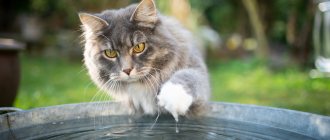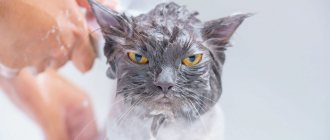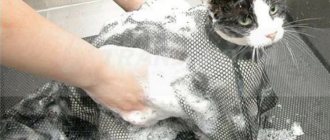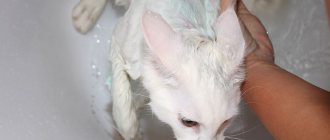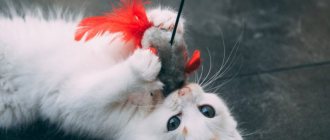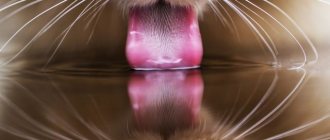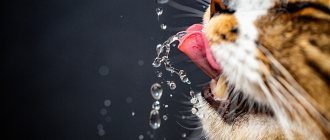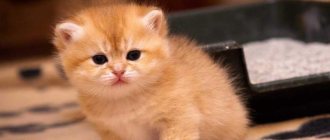Every cat owner's worst nightmare is bathing their furry friend. Unlike their larger felines (tigers, lions), which enjoy swimming in wild waters, small domestic cats do not seem to enjoy being near water. Oddly enough, we also often see cats curiously sticking their paws out to play with the flowing water from a faucet or fountain.
So what is the relationship between cats and water? Do cats have a phobia of being near water, or do they just hate showering like most of us do on rainy days?
While the whole cat-water relationship seems like a silly love-hate scenario, there is some interesting science behind cats' dislike of water.
Mr. Cat Recommends: Legends of Cat Hydrophobia
In fact, cats are not afraid of water at all and even kittens can swim. Most people don’t want it, they don’t like it. And they have reasons for that. Even a couple of legends about Noah's Ark try to explain this fear and hostility.
According to the first version of the story about “every creature in pair,” Noah announced to all the animals gathered on the ark that during the long voyage there should be no quarrels or attacks on each other. But then the Devil himself came into play and, turning into a huge rat, began to gnaw a hole in the hold.
The cat, noticing that the ship was in danger of sinking, caught the rat and strangled it. And the angry Noah ordered to throw the animal into the water as a violator of peaceful neutrality. Later, the savior of mankind was told how the events actually happened and the wet, poor fellow floating behind the ark was returned on board. But all cat descendants have a dislike for water.
According to another legend, there could not have been a cat on Noah’s Ark, since this species had not yet appeared on earth. But the rats began to overcome all the participants in the rescue expedition during the swim. And then Noah ordered Leo to destroy all rodents. The king of beasts did not consider it possible for himself to chase small nimble creatures. He sneezed and created a cat. It was she who destroyed all the pests, but since then she has had a dislike for water and has been wary.
But if you don’t mention myths, cats’ dislike for water is quite explainable at the level of genetic memory. After all, their ancestors appeared in hot, dry steppes and deserts and simply did not know rivers, lakes and seas. Therefore, they have no desire for voluntary swimming. On the contrary, those cat species that historically grew up near water are excellent swimmers and fishermen.
Enhancing your own scent
All cats are natural predators. Their desire for cleanliness is due to the desire to get rid of all foreign odors and become invisible to the sense of smell of prey and larger predators. It's not for nothing that all cats instinctively lick their lips every time someone touches their fur. These habits and needs are inherent in cats at the genetic level.
The main causes of hydrophobia in cats
The main reasons why cats don't like bathing are as follows.
Possible hypothermia
Between the fur and skin of any cat there is a layer of air, which serves as a kind of insulating layer that prevents the body from hypothermia. But when the hairs get wet, they adhere tightly to the skin, become unable to retain air near the body, and the wonderful thermal insulation disappears. After all, even after washing in the bathroom, the pet begins to tremble, desperately freeze and strive to quickly dry the fur coat with its tongue in order to warm up and regain its ability to insulate.
Risk of overheating
Actually, this phobia is associated with the same reason - when natural thermal insulation is violated in a hot climate, sudden overheating occurs. After all, a cat has practically no sweat glands, and even by breathing frequently with its tongue hanging out, like dogs, it cannot quickly reach the desired body temperature.
Enhancing your own scent
The cat is a natural predator. Her increased attention to the cleanliness of her own body and fur is associated, among other reasons, with the hunter's instinct. After all, a pet licks itself, even if you just pet it.
The desire to remove all odors from oneself, to become invisible and imperceptible to potential enemies or victims is genetically in the animal’s blood.
When the fur gets wet, the cat's own fluids intensify. And it will take a lot of time to dry the fur and “disguise” again. This is another reason for the dislike of water.
Threat of attack
As a result, a wet cat with a strong-smelling wet fur will easily become the target of an attack by a larger predator. The reluctance to transform from hunter to prey forces the animal to avoid water.
Possibility of infection
Like any wild animal, a cat intuitively knows what is good for it in the world around it and what is dangerous. Wet wool instantly attracts dirt and dust, and it does not know what bacteria the water in the pond is contaminated with. The need to lick all this dirt from the fur makes the pet wary of bathing.
Physical factors
Some physical factors are one of the reasons why cats avoid contact with water.
High body temperature
Research shows that a cat's normal body temperature is between 36.7°C and 38.9°C, which is higher than that of a human. Since cats have a higher body temperature, their heat tolerance is also quite high. Thus, they generally prefer warmth and heat.
Even when domesticated, cats still have an innate predatory nature. They have an active metabolism and love to hunt. All of these activities require energy, which they obtain by conserving body heat or relying on external heat sources. This is why cats sunbathe or curl up in a ball... They know how to optimize their body heat.
Being in water, however, lowers their body temperature, which is not good for their health. Therefore, cats prefer to stay away from water.
Fur
You've probably seen dogs play with water and easily shake it off their fur, but cats can't do it. This is because their coats are completely different. A dog's fur is more like a raincoat, which sheds water easily, while a cat's fur is like wool, which gets wet and becomes heavier when wet.
A cat's fur can have two to three layers, depending on the cat's breed.
- Undercoat: An inner layer with short, fine hairs provides warmth and insulation.
- Guard Hair: The outer layer with longer hairs protects the undercoat.
- Austen coat: A layer of secondary hair between the undercoat and the guard hair.
Guard hairs versus undercoat: The longer ones are guard hairs and the shorter ones are undercoat hairs.
Cat fur is not waterproof, so when the cat is drenched in water, these layers become wet and lower the animal's body temperature.
If your cat has long hair, water will weigh it down; which makes it difficult for a cat to stay afloat and not drown. It will also affect their "cat reflexes" and make them feel uncomfortable. If the fur is shorter, exposure to water will make the cat very cold, which is also not good since their optimal temperature is warmer!
Cats that can swim
However, there are breeds of cats that simply adore water and are willing to spend most of their time in it.
For example, Turkish Vans. This natural species is named after Lake Van in Anatolia, where the amazing cats were first discovered.
The ancestors of the Vanir developed separately in the area of lakes for a long time. Their main source of food was fish. Apparently, due to gradual natural mutation, the phenomenon of this breed arose. Their wool has amazing water-repellent properties. The skin near the hair follicle of any hair produces a special fatty secretion. And every hair is as if in an amazing protective cocoon.
Turkish van
When the Turkish Van comes out of the water, it can be seen simply rolling off his fur. And as soon as the cat just shakes himself off, his coat turns out to be completely dry. Therefore, this animal does not need to quickly lick itself in order to “drown out” its own smell or restore natural thermal insulation.
Vans aren't the only ones with water-repellent coats. There are quite a lot of natural breeds with such properties - these are the Norwegian Forest, the Kuril and American Bobtails, the Egyptian Mau, the Siamese, the Maine Coon.
Siamese cat
Even among hybrid breeds there are water lovers. A striking example is Bengal. His wild ancestor, the Asian leopard cat, always settles near his “personal” stream. More precisely, he prefers to own two small bodies of water - one for natural needs (so that the smell disappears and the lair cannot be detected), and the second for drinking and swimming.
And the Bengal cat retained its love of water and many of its ALC habits. Before she starts drinking, she “digs” the water. After all, the stream should be covered with leaves. He also enjoys playing in a pond or bathtub with toys, fishing and swimming.
Bengal cat
A unique wild species is widely known - the fishing cat or speckled cat. This fairly large predator lives mainly in Asia, India and Indochina. The animal is not only an excellent swimmer, it is capable of diving to a depth of two meters in the hunt for large fish. On its paws there are special membranes between the toes, which allow it to develop great speed in the water, catching up with prey.
Many species of tigers and jaguar are also excellent swimmers. For example, the Indian tiger is able to swim across the Ganges at its widest point, which is a distance of about 500 m.
Why does a dog like to swim, but a cat doesn't?
By unspoken agreement, some dogs rescue cats from the water
Indeed, most dogs get undisguised pleasure from bathing. This is easy to explain:
- upon leaving the water, the dog immediately shakes itself off, rather than licking its fur;
- their hairs are often longer, so they accumulate heat faster;
- Dogs maintain temperature balance by sticking out their tongue when breathing, but cats cannot do this;
- When hunting, the dog is of little concern about its own scent, since it runs after the prey over long distances, rather than sneaking up covertly.
Is it possible to stop a cat from being afraid of water?
Thus, cats are not at all afraid of water. What pushes them away from her is natural caution and genetic memory. If you set a goal, you can quickly teach your pet to swim. But it is better to start learning from an early age and gradually.
On a hot day, you can place a fairly large container of water in the center of the room. First, gently wet the cat’s paws and run wet hands over the fur. Under no circumstances should you scold your pet if it gets scared, scratches, bites and runs away. Sooner or later he will begin to show independent interest.
It's even better to turn this process into a game. To do this, you can release fish into the water or throw toys. Cats will definitely be interested.
You can open the tap from time to time, for example in the kitchen. Flowing water attracts all animals without exception. Pets begin to play with the stream, wet their paws and faces, gradually getting used to water procedures.
1111
Wet wool smells bad
The video clearly demonstrates why cats are afraid of water: watch any of the popular videos - a wet cat either screams, or breaks out, or freezes and shrinks, as if trying to shrink in size, appear small and invisible.
Why does she react this way? Apparently, because the animal’s hunting instinct or self-preservation instinct is triggered: while waiting for prey or hiding from ill-wishers, cats hid and tried not to give themselves away, not even by smell.
Attention! Wet fur has a very strong smell that not only the cat can hear. So the animal protests - it is afraid of being noticed.
Wet wool has a very strong odor
